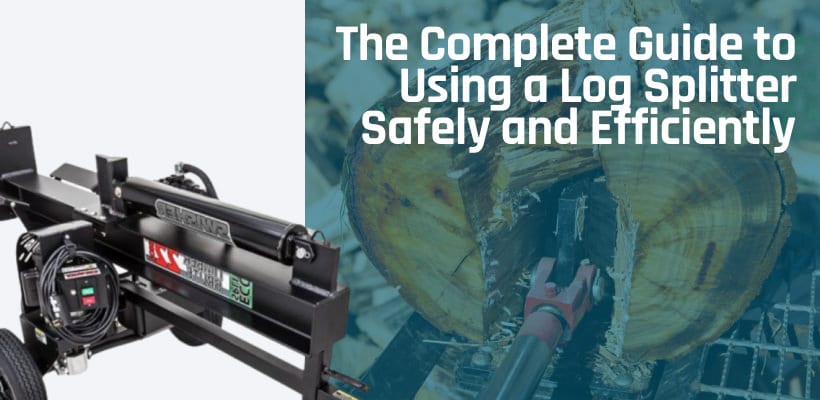
How to Pick Your Log Splitter Tonnage
Selecting the appropriate tonnage for your log splitter is not just a matter of power; it’s about matching the machine’s capabilities to your specific wood-splitting needs. Whether you’re a homeowner dealing with firewood, a hobbyist, or a professional in lumber processing, understanding the nuances of log splitter tonnage can greatly enhance your work efficiency.
This guide delves into various factors like dry and wet wood requirements, force application, horsepower, and cycle times at different GPMs (Gallons Per Minute) to help you make an informed decision. Let’s break down these elements to ensure you choose a log splitter that perfectly aligns with your demands.

Dry Tonnage Required
Choosing the right tonnage for splitting dry wood is crucial. Generally, dry wood requires less force than wet wood. A log splitter with a tonnage of 4-6 tons is usually sufficient for small, domestic tasks.
However, opt for a splitter with 10-12 tons of force for larger logs or hardwoods, even if dry. Remember, overestimating your needs can lead to unnecessary expenditure, while underestimating can hamper efficiency.

Wet Tonnage Required
Wet wood, freshly cut or not properly seasoned, demands more power to split. A tonnage of 12-20 tons is recommended for most wet wood splitting tasks. If you’re frequently dealing with large diameters or particularly knotty wood, consider splitters with upwards of 20-30 tons.

The key is balancing power with practicality; more isn’t always better, but it can be essential for tough jobs.
Force Applied
The force applied by a log splitter is a direct function of its tonnage. Higher tonnage means more splitting force, which is essential for tough, knotty, or large logs. The trick lies in assessing your regular wood type and size to choose a splitter that applies sufficient force without overkill.

Horse Power Required
Horsepower (HP) relates to the engine’s power in a gas log splitter. For smaller residential models, 3-5 HP should suffice. 10-15 HP engines are more appropriate for larger, commercial-grade splitters. Electric splitters, conversely, are measured in amps, with higher amperage indicating more power.

Two-Stage GPM Breakdown
A two-stage pump is common in log splitters, offering a balance between speed and power. At low pressure, the pump moves fluid faster, speeding up the splitter’s cycle time. When encountering resistance, it shifts to high pressure at a slower flow, maximizing force. Understanding your splitter’s Gallons Per Minute (GPM) rating at both stages helps in selecting the right model for efficiency and power.

Cylinder Oil Capacity
The oil capacity of a log splitter’s cylinder impacts its efficiency and maintenance needs. Larger cylinders require more oil, providing smoother operation for heavier tasks but necessitating more frequent oil checks and changes. Ensure your splitter has an adequate oil capacity for the size and frequency of your wood-splitting tasks.

8 GPM Cycle Time
With an 8 GPM pump, the cycle time — the duration it takes for the splitter to complete a split and return — is relatively quick, making it ideal for smaller, less challenging splitting tasks. This rate is well-suited for residential use where efficiency is key, but the wood size and hardness are moderate.

11 GPM Cycle Time
An 11 GPM pump strikes a balance, offering a faster cycle time suitable for medium-sized logs and semi-regular use. This is a common choice for those who need a bit more power than what residential models offer but don’t require industrial-level performance.

13 GPM Cycle Time
A log splitter with a 13 GPM pump provides an even quicker cycle time, reducing the effort and time needed for splitting larger or harder logs. This is often the choice for frequent users or those with larger volumes of wood to process.

16 GPM Cycle Time
A 16 GPM pump offers a high-speed cycle for commercial or heavy-duty residential use. This facilitates the rapid processing of large quantities of wood, suitable for businesses or for those preparing large amounts of firewood.

22 GPM Cycle Time
Splitters with a 22 GPM pump are high-end, professional-grade tools that offer extremely fast cycle times. These are designed for constant, heavy-duty use and can easily handle almost any wood-splitting task.

28 GPM Cycle Time
At the top of the range, a 28 GPM pump provides the fastest possible cycle time. This is for industrial use, where efficiency and time management are crucial. Such models can easily handle the toughest, largest logs but are typically overkill for anything less than commercial logging operations.















